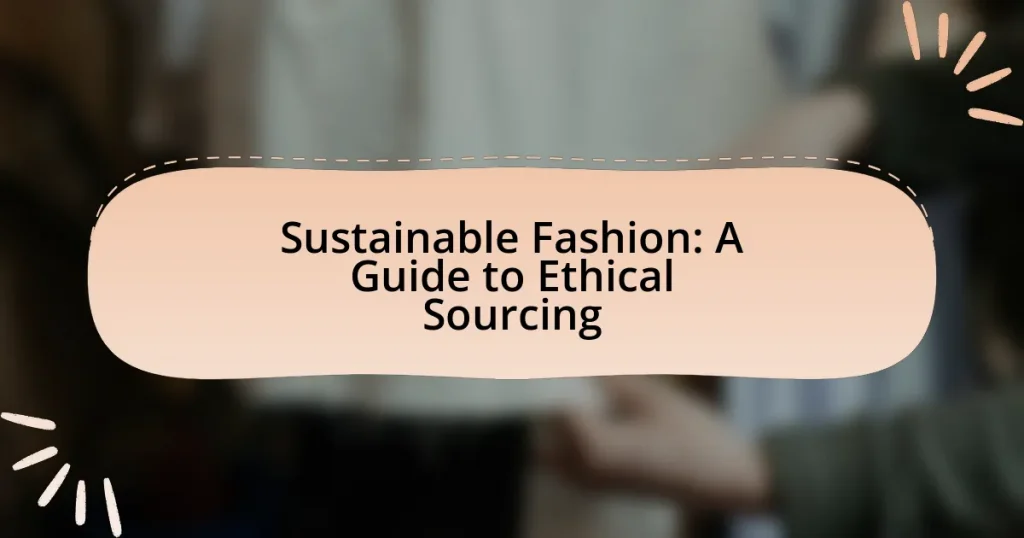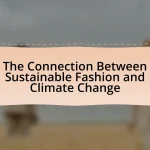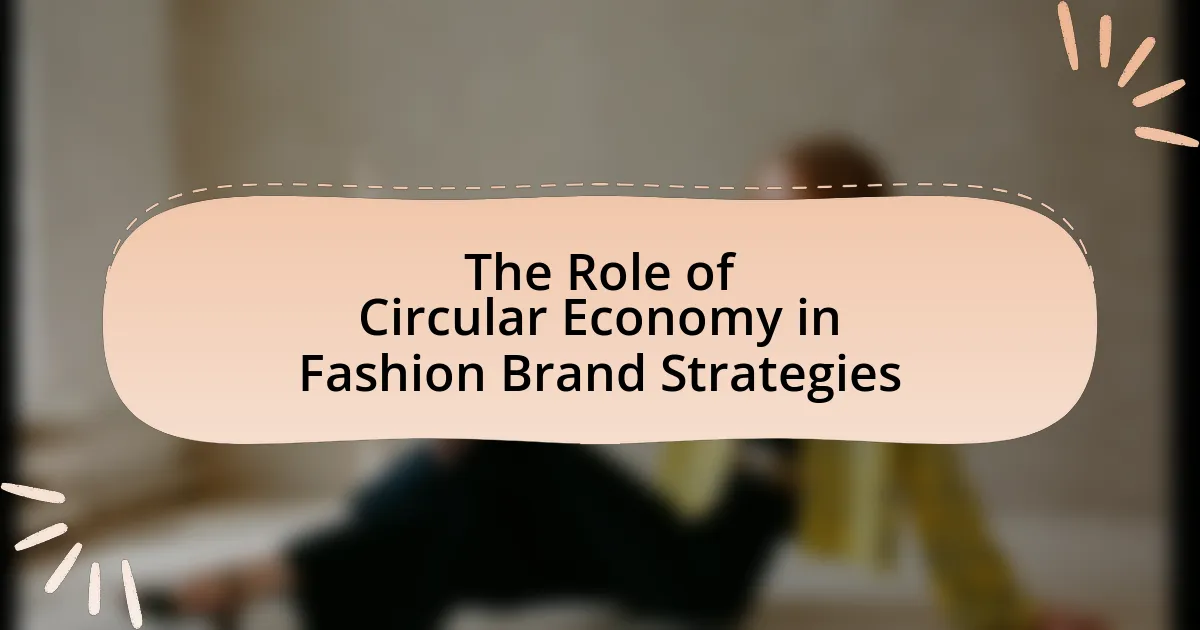Sustainable fashion is defined as the design, production, and consumption of clothing and accessories that minimize environmental impact and promote social responsibility. This article explores the differences between sustainable and traditional fashion, highlighting key principles such as ethical sourcing, environmental responsibility, and social equity. It addresses the importance of sustainable fashion for the environment, the challenges it faces, and the role of consumer habits and brand practices in promoting sustainability. Additionally, the article discusses ethical sourcing, its criteria, benefits, and its impact on workers’ rights, while providing practical steps for consumers to support sustainable fashion initiatives.
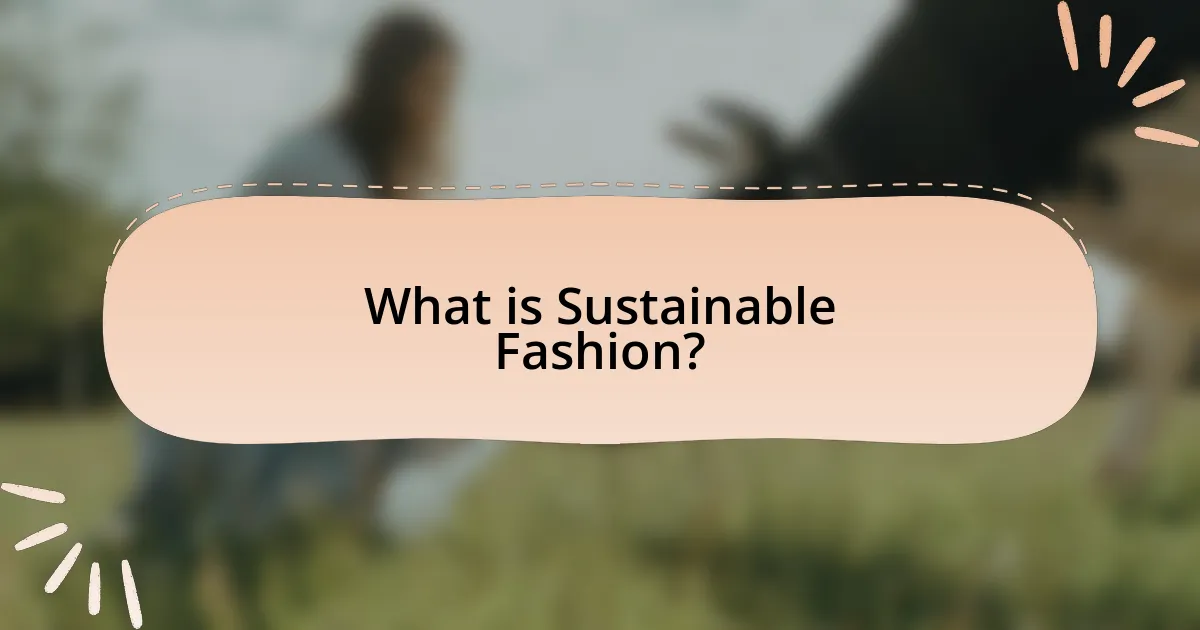
What is Sustainable Fashion?
Sustainable fashion refers to the design, production, and consumption of clothing and accessories in a manner that minimizes environmental impact and promotes social responsibility. This approach encompasses the use of eco-friendly materials, ethical labor practices, and sustainable manufacturing processes. According to the Global Fashion Agenda’s 2021 report, the fashion industry is responsible for 10% of global carbon emissions, highlighting the urgent need for sustainable practices to mitigate climate change.
How does Sustainable Fashion differ from traditional fashion?
Sustainable fashion differs from traditional fashion primarily in its focus on environmental and social responsibility. While traditional fashion often prioritizes rapid production and consumption, leading to significant waste and exploitation of labor, sustainable fashion emphasizes ethical sourcing, eco-friendly materials, and fair labor practices. For instance, sustainable fashion brands frequently utilize organic cotton or recycled materials, which reduce environmental impact, whereas traditional brands may rely on synthetic fabrics that contribute to pollution. This distinction is supported by the fact that the fashion industry is responsible for approximately 10% of global carbon emissions, highlighting the urgent need for sustainable practices to mitigate climate change.
What are the key principles of Sustainable Fashion?
The key principles of Sustainable Fashion include ethical sourcing, environmental responsibility, and social equity. Ethical sourcing emphasizes the use of materials that are produced in a manner that respects both the environment and the rights of workers. Environmental responsibility focuses on minimizing waste, reducing carbon footprints, and utilizing sustainable materials, such as organic cotton or recycled fabrics. Social equity ensures fair labor practices and promotes inclusivity within the fashion industry. These principles are supported by various studies, such as the 2020 report by the Ellen MacArthur Foundation, which highlights the importance of circular fashion in reducing environmental impact and promoting sustainability.
Why is Sustainable Fashion important for the environment?
Sustainable fashion is important for the environment because it reduces waste, conserves resources, and minimizes pollution. The fashion industry is responsible for approximately 10% of global carbon emissions and is a significant contributor to water pollution, with textile dyeing being one of the largest polluters of clean water. By utilizing eco-friendly materials, promoting recycling, and implementing ethical production practices, sustainable fashion significantly lowers the environmental impact associated with traditional fashion manufacturing. For instance, using organic cotton can reduce water usage by up to 91% compared to conventional cotton farming.
What are the main challenges facing Sustainable Fashion?
The main challenges facing Sustainable Fashion include high production costs, lack of consumer awareness, and supply chain complexities. High production costs arise from the use of eco-friendly materials and ethical labor practices, making sustainable options less competitive in price compared to fast fashion. Lack of consumer awareness limits demand for sustainable products, as many consumers prioritize affordability and style over sustainability. Additionally, supply chain complexities hinder transparency and traceability, making it difficult for brands to ensure ethical sourcing and production practices. These challenges collectively impede the growth and adoption of sustainable fashion in the industry.
How do consumer habits impact Sustainable Fashion?
Consumer habits significantly impact sustainable fashion by driving demand for eco-friendly products and influencing brands to adopt ethical practices. When consumers prioritize sustainability, they encourage companies to invest in sustainable materials, ethical labor practices, and transparent supply chains. For instance, a 2021 survey by McKinsey & Company found that 67% of consumers consider the use of sustainable materials important when making fashion purchases. This shift in consumer behavior compels brands to innovate and align their offerings with sustainability goals, ultimately leading to a more responsible fashion industry.
What role do brands play in promoting Sustainable Fashion?
Brands play a crucial role in promoting Sustainable Fashion by influencing consumer behavior and setting industry standards. They achieve this through the adoption of eco-friendly materials, transparent supply chains, and ethical labor practices, which collectively encourage consumers to make more sustainable choices. For instance, brands like Patagonia and Stella McCartney have pioneered the use of organic cotton and recycled materials, demonstrating that sustainable practices can be both profitable and appealing to consumers. Additionally, brands often engage in educational campaigns that raise awareness about the environmental impact of fashion, further driving the demand for sustainable options. This multifaceted approach not only enhances brand loyalty but also contributes to a broader cultural shift towards sustainability in the fashion industry.
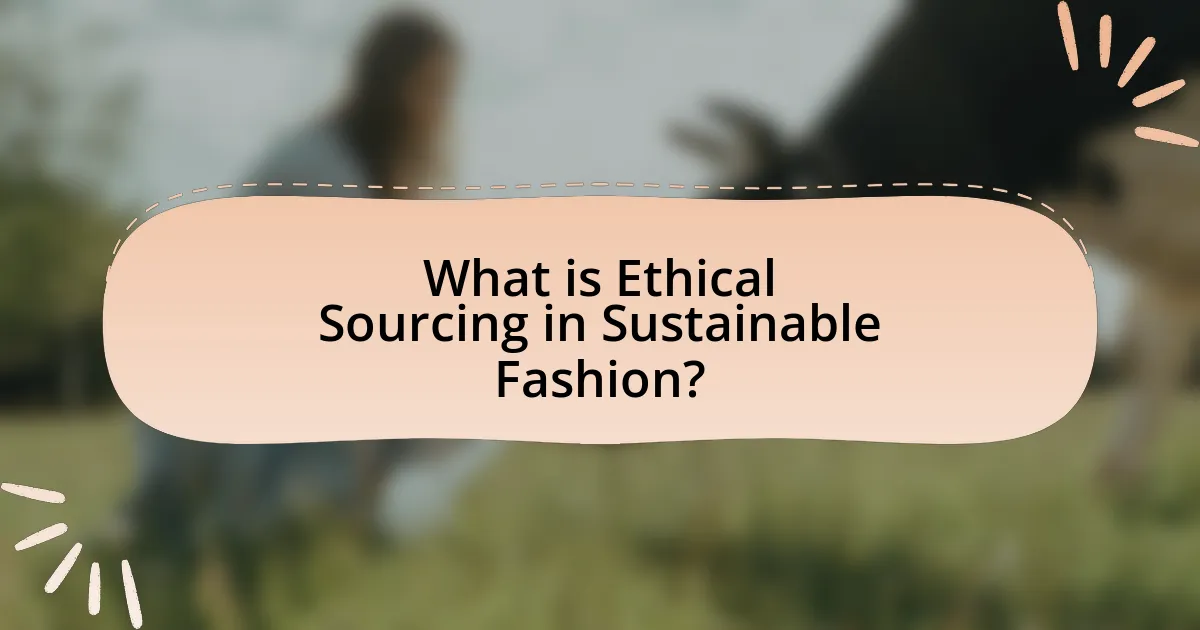
What is Ethical Sourcing in Sustainable Fashion?
Ethical sourcing in sustainable fashion refers to the practice of obtaining materials and products in a manner that prioritizes social and environmental responsibility. This approach ensures that the production processes respect human rights, provide fair wages, and minimize environmental impact. For instance, brands that engage in ethical sourcing often work with suppliers who adhere to fair labor practices and sustainable farming methods, thereby reducing exploitation and promoting ecological balance. According to the Ethical Fashion Forum, ethical sourcing not only enhances brand reputation but also contributes to a more sustainable and equitable fashion industry.
How does Ethical Sourcing contribute to Sustainable Fashion?
Ethical sourcing significantly contributes to sustainable fashion by ensuring that materials are obtained in a manner that respects both environmental and social standards. This practice involves selecting suppliers who adhere to fair labor practices, minimize environmental impact, and promote animal welfare. For instance, according to the Ethical Fashion Forum, brands that engage in ethical sourcing can reduce their carbon footprint by up to 30% through responsible material selection and production processes. Furthermore, ethical sourcing fosters transparency in the supply chain, allowing consumers to make informed choices that align with their values, thereby driving demand for sustainable practices in the fashion industry.
What are the criteria for Ethical Sourcing?
The criteria for ethical sourcing include fair labor practices, environmental sustainability, and transparency in supply chains. Fair labor practices ensure that workers receive fair wages, work in safe conditions, and are not subjected to exploitation or discrimination. Environmental sustainability involves sourcing materials that minimize harm to the environment, such as using organic or recycled materials and reducing carbon footprints. Transparency in supply chains requires companies to disclose their sourcing practices and the origins of their materials, allowing consumers to make informed choices. These criteria are essential for promoting responsible consumption and production in the fashion industry.
How can brands ensure their sourcing practices are ethical?
Brands can ensure their sourcing practices are ethical by implementing a comprehensive supply chain transparency policy. This involves conducting regular audits of suppliers to verify compliance with labor laws, environmental regulations, and ethical standards. For instance, a study by the Ethical Trading Initiative found that brands that engage in transparent sourcing practices can significantly reduce instances of labor exploitation and environmental harm. Additionally, brands can collaborate with third-party organizations to certify their suppliers, ensuring adherence to ethical guidelines. By prioritizing these measures, brands can foster responsible sourcing that aligns with sustainable fashion principles.
What are the benefits of Ethical Sourcing?
Ethical sourcing provides multiple benefits, including improved brand reputation, enhanced customer loyalty, and positive social impact. Companies that engage in ethical sourcing practices often experience increased consumer trust, as 66% of global consumers are willing to pay more for sustainable brands, according to a Nielsen report. Additionally, ethical sourcing can lead to better quality products, as suppliers committed to ethical practices tend to prioritize quality and sustainability. This approach also fosters fair labor practices, contributing to better working conditions and wages for workers, which can enhance employee satisfaction and retention.
How does Ethical Sourcing affect brand reputation?
Ethical sourcing significantly enhances brand reputation by demonstrating a commitment to social responsibility and sustainability. Brands that prioritize ethical sourcing practices, such as fair labor conditions and environmentally friendly materials, often gain consumer trust and loyalty. According to a 2021 survey by Nielsen, 66% of global consumers are willing to pay more for sustainable brands, indicating that ethical sourcing can lead to increased sales and positive brand perception. Furthermore, companies like Patagonia and TOMS have built strong reputations by integrating ethical sourcing into their business models, showcasing that such practices can differentiate a brand in a competitive market.
What impact does Ethical Sourcing have on workers’ rights?
Ethical sourcing significantly enhances workers’ rights by ensuring fair labor practices and safe working conditions. Companies that adopt ethical sourcing policies commit to upholding labor standards, which often include fair wages, reasonable working hours, and the prohibition of child labor. For instance, a report by the Ethical Trading Initiative highlights that brands implementing ethical sourcing practices have seen improvements in worker satisfaction and retention rates, as well as reductions in workplace accidents. This commitment not only protects workers but also fosters a more sustainable and equitable supply chain.
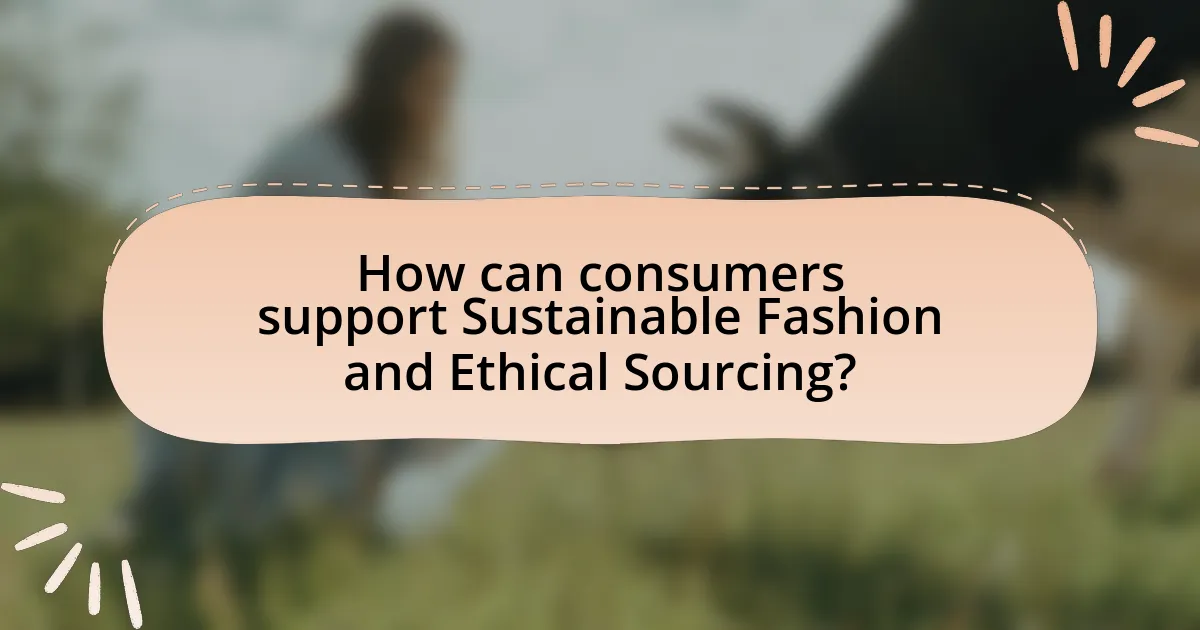
How can consumers support Sustainable Fashion and Ethical Sourcing?
Consumers can support Sustainable Fashion and Ethical Sourcing by choosing to purchase from brands that prioritize environmentally friendly practices and fair labor conditions. By researching and selecting companies that use sustainable materials, such as organic cotton or recycled fabrics, consumers can reduce their environmental impact. Additionally, supporting brands that are transparent about their supply chains and labor practices ensures that workers are treated ethically. According to a 2021 report by the Global Fashion Agenda, sustainable fashion can significantly reduce carbon emissions and water usage, highlighting the importance of consumer choices in driving industry change.
What are the best practices for consumers interested in Sustainable Fashion?
Consumers interested in sustainable fashion should prioritize purchasing from brands that demonstrate transparency in their supply chains and use eco-friendly materials. Research indicates that brands committed to sustainability often disclose their sourcing practices, which helps consumers make informed choices. For instance, a 2021 report by the Fashion Transparency Index found that only 40% of major fashion brands disclose their suppliers, highlighting the importance of seeking out those that do. Additionally, consumers should consider buying second-hand clothing, as it reduces waste and extends the lifecycle of garments. According to the Ellen MacArthur Foundation, extending the life of clothing by just nine months can reduce carbon, water, and waste footprints by 20-30%. Lastly, supporting local artisans and sustainable brands fosters ethical production practices and contributes to local economies.
How can consumers identify sustainable brands?
Consumers can identify sustainable brands by looking for certifications such as Fair Trade, GOTS (Global Organic Textile Standard), and B Corp, which indicate adherence to environmental and social standards. These certifications provide a reliable framework for assessing a brand’s commitment to sustainability, as they require companies to meet specific criteria regarding ethical labor practices, environmental impact, and transparency. Additionally, consumers can research a brand’s supply chain practices, materials used, and overall corporate social responsibility initiatives, as brands that prioritize sustainability often disclose this information on their websites or through sustainability reports.
What role does second-hand shopping play in Sustainable Fashion?
Second-hand shopping plays a crucial role in sustainable fashion by significantly reducing waste and resource consumption associated with the production of new clothing. By purchasing pre-owned garments, consumers extend the lifecycle of clothing, which helps to mitigate the environmental impact of the fashion industry, known to be responsible for 10% of global carbon emissions and substantial water usage. Studies indicate that buying second-hand can reduce carbon footprints by up to 82% compared to buying new items. This practice not only promotes a circular economy but also encourages mindful consumption, making it a vital component of sustainable fashion initiatives.
What are some common misconceptions about Sustainable Fashion?
Common misconceptions about sustainable fashion include the belief that it is always more expensive, that it compromises style, and that it is only about eco-friendly materials. In reality, sustainable fashion can be affordable due to the rise of second-hand markets and brands that prioritize ethical production without high price tags. Additionally, sustainable fashion encompasses a wide range of styles and designs, proving that eco-conscious choices do not sacrifice aesthetics. Furthermore, while eco-friendly materials are a significant aspect, sustainable fashion also involves fair labor practices, reducing waste, and promoting longevity in clothing, making it a holistic approach to ethical sourcing.
How can education help dispel myths about Sustainable Fashion?
Education can dispel myths about Sustainable Fashion by providing accurate information and fostering critical thinking. Through structured learning, individuals can understand the environmental and social impacts of the fashion industry, debunking misconceptions such as the belief that sustainable fashion is unaffordable or less stylish. Research indicates that informed consumers are more likely to make ethical choices; for instance, a study by the Fashion Institute of Technology found that 70% of consumers who received education on sustainable practices were more inclined to support eco-friendly brands. This knowledge empowers individuals to challenge stereotypes and promotes a more informed dialogue around sustainable practices in fashion.
Why is transparency important in Sustainable Fashion?
Transparency is important in sustainable fashion because it builds trust between brands and consumers, ensuring accountability in sourcing and production practices. When brands disclose information about their supply chains, including labor conditions and environmental impact, consumers can make informed choices that align with their values. Research by the Fashion Transparency Index indicates that 75% of consumers want to know more about the origins of their clothing, highlighting a growing demand for ethical practices. This transparency not only fosters consumer loyalty but also encourages brands to adopt more sustainable practices, ultimately contributing to a more responsible fashion industry.
What practical steps can individuals take to promote Sustainable Fashion?
Individuals can promote Sustainable Fashion by making conscious choices in their clothing purchases and care. This includes opting for brands that prioritize ethical sourcing, using sustainable materials, and ensuring fair labor practices. Additionally, individuals can reduce their fashion footprint by buying second-hand clothing, participating in clothing swaps, and donating or recycling garments instead of discarding them. According to a report by the Ellen MacArthur Foundation, extending the life of clothing by just nine months can reduce carbon, water, and waste footprints by around 20-30%. By adopting these practices, individuals contribute to a more sustainable fashion industry.
